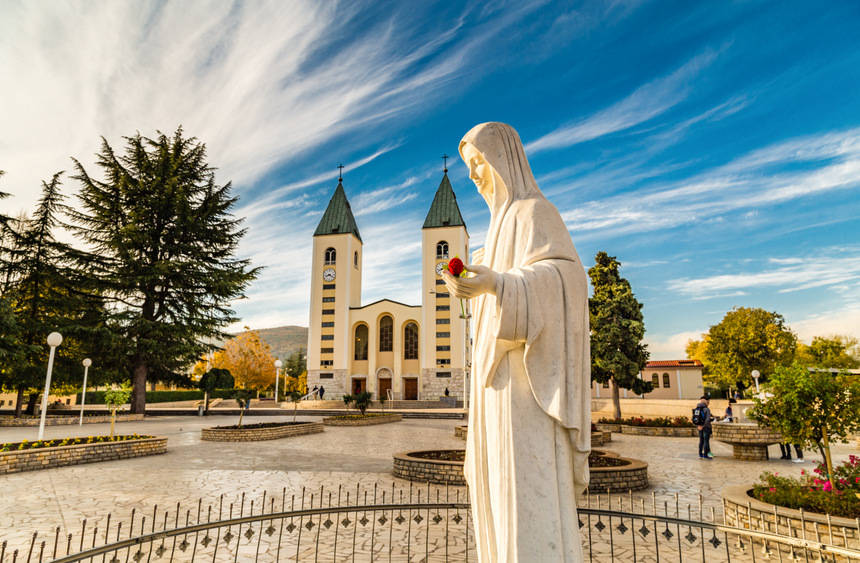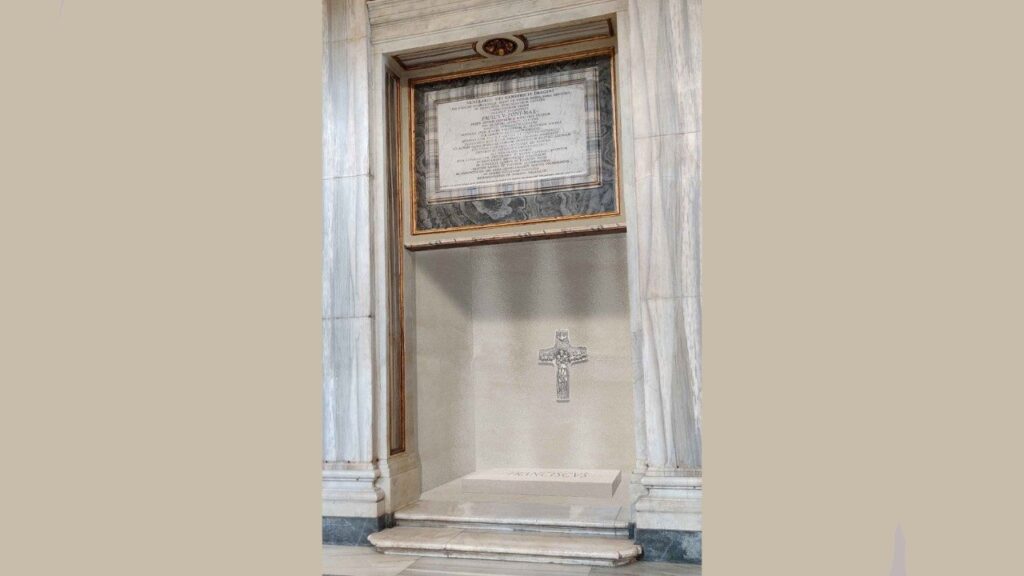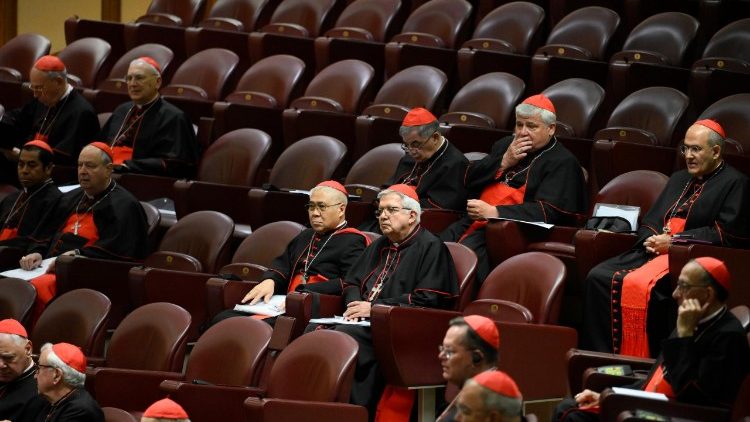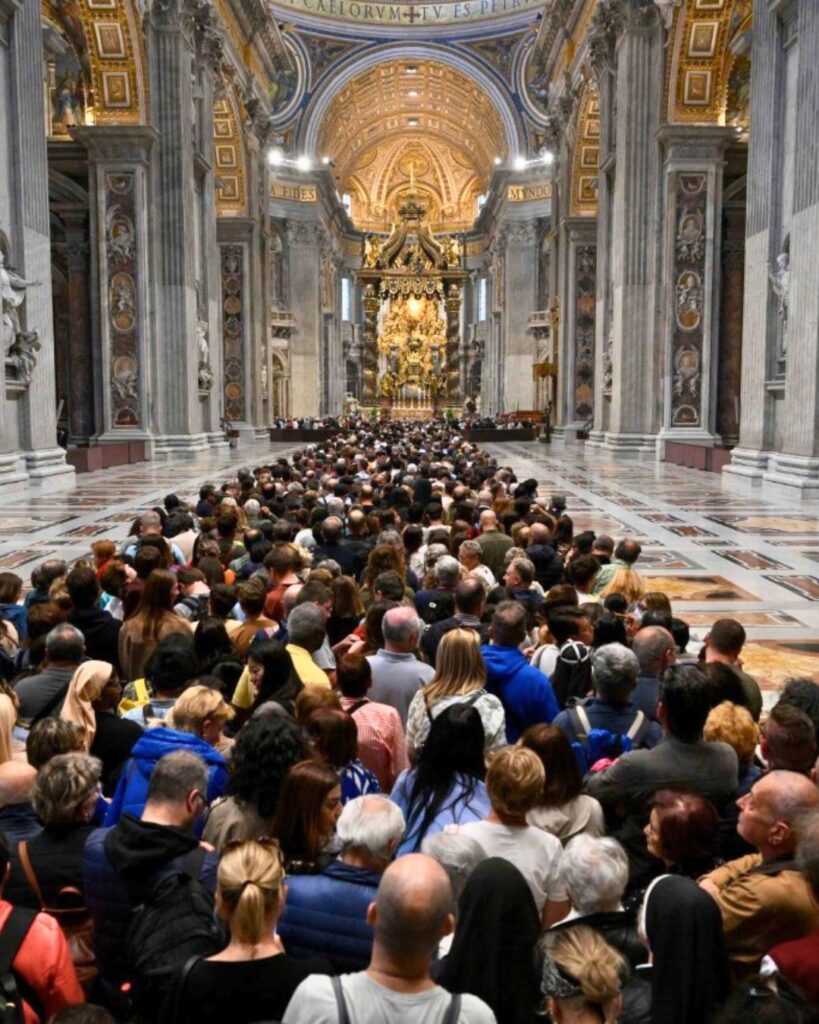Pope Francis grants ‘Nulla Osta’ for Medjugorje
The Dicastery for the Doctrine of the Faith, with the assent of Pope Francis, grants approval for devotion linked to Medjugorje, recognizing the abundant spiritual fruits received at the Sanctuary of the Queen of Peace without making a declaration on the supernatural character of the Marian apparitions

“The time has come to conclude a long and complex history that has surrounded the spiritual phenomena of Medjugorje. It is a history in which bishops, theologians, commissions, and analysts have expressed a series of divergent opinions.”
Beginning with the words “The Queen of Peace,” the Note about the Spiritual Experience connected with Medjugorje was signed by Cardinal Víctor Manuel Fernández and Monsignor Armando Matteo, respectively Prefect and Secretary for the Doctrinal Section of the Dicastery for the Doctrine of the Faith.
Pope Francis approved the Note on August 28. It recognizes the goodness of the spiritual fruits linked to Medjugorje, authorizing the faithful to adhere to it – according to the new Norms for discerning these phenomena – since “many positive fruits have been noted in the midst of a spiritual experience, while negative and dangerous effects have not spread among the People of God.”
The overall judgment of the messages is generally positive, though several clarifications are offered regarding certain expressions. “It is important to clarify from the outset that the conclusions of this Note do not imply a judgment about the moral life of the alleged visionaries,” and, in any case, the spiritual gifts “do not necessarily require those involved to have moral perfection.”
Positive fruits
The places linked to the Medjugorje phenomenon have become pilgrimage destinations for people from around the world.
“The positive fruits are most evident in the promotion of a healthy practice of a life of faith, in accordance with the tradition of the Church,” reads the Note.
It recognizes “abundant conversions” of people who have discovered or rediscovered their faith, many people have returned to confession and sacramental communion, and numerous vocations have been confirmed, as well as “many reconciliations between spouses, and the renewal of marriage and family life.”
“It should be noted,” adds the Note, “that such experiences occur above all in the context of pilgrimages to the places associated with the original events rather than in meetings with the ‘visionaries’ to be present for the alleged apparitions.”
“Numerous healings” have also been reported. The parish of the small town in Herzegovina has grown into a place of worship, prayer, seminars, spiritual retreats, youth gatherings. “People seem to visit Medjugorje mainly to renew their faith rather than to seek help with specific requests,” says the Note.
Charitable works have also emerged, including the care of orphans, drug addicts, and people with disabilities, and the Note points to the presence of Orthodox Christian groups and Muslims at the Sanctuary.
The message of peace
The Dicastery’s Note continues by examining the central aspects of the messages, starting with that of peace understood not only as the absence of war but also in a spiritual, familial, and social sense. The most original title that Mary attributes to herself is indeed “Queen of Peace.”
“I have presented myself here as the Queen of Peace to tell everyone that peace is necessary for the salvation of the world. Only in God can you find true joy, which is the source of true peace. Therefore, I ask for conversion” (June 16, 1983).
This peace is the fruit of lived charity, which “also implies a love for those who are not Catholic,” an aspect better understood “in the ecumenical and interreligious context of Bosnia and Herzegovina, which has been marked by a terrible war with strong religious components.”
God at the center
There is a frequent invitation to confident abandonment to God who is love: “We can see a nucleus of messages in which Our Lady does not place herself at the center but shows herself to be fully directed toward our union with God.”
Furthermore, “the intercession and work of Mary are shown to be clearly subordinate to Jesus Christ, who is the author of grace and salvation for every person.”
Mary intercedes, but it is Christ who “gives the strength. Therefore, her whole maternal work consists in motivating us to turn to Christ.”
“He will give you strength and joy in this time. I am close to you with my intercession” (November 25, 1993).
Additionally, many messages invite the faithful to recognize the importance of seeking the help of the Holy Spirit: “People are wrong when they turn solely to the saints to ask for something. The important thing is to pray to the Holy Spirit to descend upon you. When you have him, you have everything” (October 21, 1983).
Call to conversion
The messages also contain “constant call to abandon a worldly lifestyle and excessive attachment to worldly goods appears in the messages, along with frequent calls for conversion, which makes true peace in the world possible.”
Conversion seems to be the focal point of the Medjugorje message. There is also “an insistent exhortation not to underestimate the gravity of evil and sin, and to take very seriously God’s call to fight against evil and the influence of Satan,” indicated as the origin of hatred, violence, and division.
Prayer and fasting are also essential to the message of Medjugorje, as well as the centrality of the Mass, the importance of fraternal communion, and the search for the ultimate meaning of existence in eternal life.
Necessary clarifications
The second part of the Note emphasizes how “a few” messages deviate from the content listed so far.
“To prevent this treasure of Medjugorje from being compromised, it is necessary to clarify possible points of confusion that can lead some small groups to distort the valuable proposition of this spiritual experience”.
If some messages are read partially, they may appear connected to “confused human experiences, theologically inaccurate expressions, or interests that are not entirely legitimate,” even if some errors may not be “not due to bad intentions, but to the subjective perception of the phenomenon.”
“In some cases, Our Lady seems to show some irritation because some of her instructions were not followed. So, she warns about threatening signs and the possibility of no longer appearing”.
However, other messages offer a correct interpretation: “Those who make catastrophic predictions are false prophets. They say, ‘In such a year, on such a day, there will be a catastrophe.’ I have always said that chastisement will come if the world does not convert. Therefore, I call everyone to conversion. Everything depends on your conversion” (December 15, 1983).
Insistence on messages
Other messages destined for the local parish sometimes seem as if Mary is seeking to control details of the spiritual and pastoral journey, “giving the impression that she wants to substitute herself for the ordinary parish structures meant for participation.”
At other times, Mary insists that everyone listen to and accept her messages, likely provoked by “the love and generous fervor of the alleged visionaries who, with goodwill, feared that the Blessed Mother’s calls for conversion and peace would be ignored.”
This insistence becomes more problematic when the messages “refer to requests that are unlikely to be of supernatural origin, such as when Our Lady gives orders about dates, places, and practicalities and when she makes decisions about ordinary matters.”
In reality, Mary herself relativizes such messages by subordinating them to the value of the Word revealed in Scripture: “Do not go in search of extraordinary things. Instead, take the Gospel, read it, and everything will be clear to you” (November 12, 1982); “Why do you ask so many questions? Every answer is in the Gospel” (September 19, 1981); “Do not believe the lying voices that speak to you about false things, a false light. You, my children, return to Scripture!” (February 2, 2018).
Synthesis of the Gospel
The Note says some messages are problematic when they attribute expressions like “my plan” and “my project” to Mary, expressions that “might create some confusion.”
“In reality, everything Mary accomplishes is always at the service of the Lord’s plan and His divine plan of salvation,” it says, adding that Christians must never “attribute to Mary a place that belongs uniquely and exclusively to the Son of God made man.”
Instead, the Dicastery for the Doctrine of the Faith emphasizes a message that can be considered a synthesis of the Gospel proposal through Medjugorje: “I desire to draw you ever closer to Jesus and his wounded heart” (November 25, 1991).
Authorization of public worship
“While this does not imply a declaration of the supernatural character of the phenomenon in question (cf. Norms, art. 22, §2), and recalling that the faithful are not obliged to believe in it, the nihil obstat [issued by the Bishop of Mostar-Duvno in agreement with the Holy See, ed.] indicates that the faithful can receive a positive encouragement for their Christian life through this spiritual proposal and it authorizes public acts of devotion.”
The Note clarifies that “the positive assessment that most of the messages of Medjugorje are edifying does not imply a declaration that they have a direct supernatural origin.”
Even though there are – as is known – various opinions “about the authenticity of some facts or certain aspects of this spiritual experience, the ecclesiastical authorities of the places where it is present are invited to ‘appreciate the pastoral value of this spiritual proposal, and even to promote its spread’.”
However, adds the Note, each diocesan bishop has the freedom and authority to make prudent decisions regarding “groups or persons who, by misusing this spiritual phenomenon, act in a mistaken way” in his own diocese.
Finally, the Dicastery invites pilgrims who visit Medjugorje “to be strongly advised that pilgrimages are not made to meet with alleged visionaries but to have an encounter with Mary, the Queen of Peace.”
Conclusion
In conclusion, the recent document of the Dicastery for the Doctrine of the Faith, approved by Pope Francis, marks a significant milestone in the long history of Medjugorje. Although the text does not declare an explicit supernatural character of the phenomena, it recognizes and values the abundant spiritual fruits it has generated, thus authorizing the practice of devotion to the Queen of Peace within a framework of prudent discernment.
The Note highlights the numerous spiritual benefits observed, such as the renewal of faith, the promotion of peace and charity, and the encouragement of conversion and sacramental life. However, it also clarifies the need to approach some messages with caution, avoiding interpretations that could divert the focus from the central Gospel message.
The message of Medjugorje, centered on peace, conversion and union with God, remains relevant to many faithful. Pilgrims are encouraged to seek an authentic encounter with Mary, Queen of Peace, and to use the experiences of Medjugorje as a means of strengthening their Christian life, without imposing a supernatural character on every aspect of the phenomenon.
The final invitation is clear: approach Medjugorje with a spirit of discernment, open to the positive fruits it can offer, while keeping the focus on the fundamental message of the Gospel and the centrality of Christ in the life of faith.
Related

Thousands of faithful bid farewell to Pope Francis in St. Peter’s Square
Exaudi Staff
26 April, 2025
2 min

Francis’s Tomb: A Legacy of Humility and Closeness
Exaudi Staff
25 April, 2025
4 min

Cardinals Intensify Their Spiritual and Pastoral Preparation at the Third General Congregation
Exaudi Staff
24 April, 2025
1 min

Rome unites in prayer: the world bids farewell to Pope Francis with love and gratitude
Exaudi Staff
24 April, 2025
2 min
 (EN)
(EN)
 (ES)
(ES)
 (IT)
(IT)

